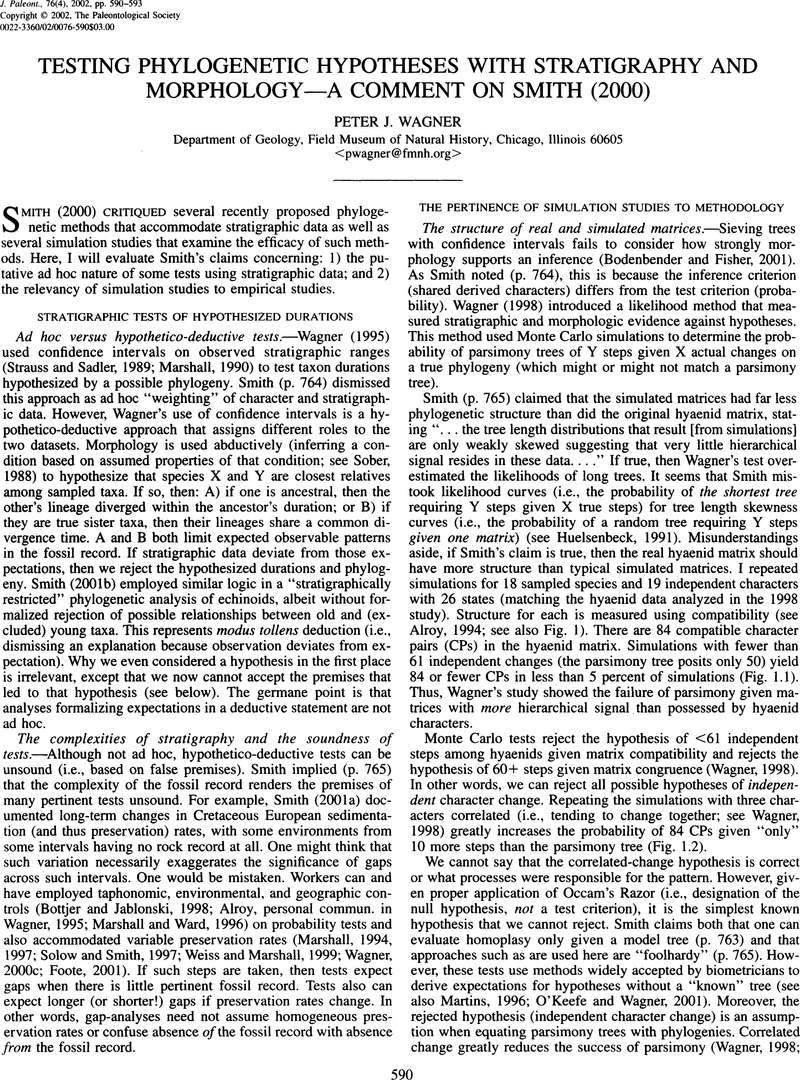No CrossRef data available.
Article contents
Testing phylogenetic hypotheses with stratigraphy and morphology—a comment on Smith (2000)
Published online by Cambridge University Press: 14 July 2015
Abstract
An abstract is not available for this content so a preview has been provided. Please use the Get access link above for information on how to access this content.

- Type
- Comment and Reply
- Information
- Copyright
- Copyright © The Paleontological Society
References
Alroy, J.
1994. Four permutation tests for the presence of phylogenetic structure. Systematic Biology, 43:430–437.CrossRefGoogle Scholar
Bodenbender, B. E., and Fisher, D. C.
2001. Stratocladistic analysis of blastoid phylogeny. Journal of Paleontology, 75:351–369.CrossRefGoogle Scholar
Bother, D. J., and Jablonski, D.
1998. Paleoenvironmental patterns in the evolution of post-Paleozoic benthic marine invertebrates. Palaios, 3:540–560.Google Scholar
Foote, M., 2001. Inferring temporal patterns of preservation, origination, and extinction from taxonomic survivorship analysis. Paleobiology, 27:602–630.2.0.CO;2>CrossRefGoogle Scholar
Fox, D. L., Fisher, D. C., and Leighton, L. R.
1999. Reconstructing phylogeny with and without temporal data. Science, 284:1816–1819.CrossRefGoogle ScholarPubMed
Goldman, N.
1993. Statistical tests of models of DNA substitution. Journal of Molecular Evolution, 36:182–198.CrossRefGoogle ScholarPubMed
Graybeal, A.
1998. Is it better to add taxa or characters to a difficult phylogenetic problem? A simulation study. Systematic Biology, 47:9–17.CrossRefGoogle ScholarPubMed
Huelsenbeck, J. P.
1991. Treelength distribution skewness: an indicator of phylogenetic information. Systematic Zoology, 40:257–270.CrossRefGoogle Scholar
Huelsenbeck, J. P., and Nielsen, R.
1999. Effects of nonindependent substitution on phylogenetic accuracy. Systematic Biology, 48:317–328.CrossRefGoogle Scholar
Huelsenbeck, J. P., and Rannala, B.
1997. Maximum likelihood estimation of topology and node times using stratigraphic data. Paleobiology, 23:174–180.CrossRefGoogle Scholar
Huelsenbeck, J. P., Rannala, B., and Masly, J. P.
2000. Accommodating phylogenetic uncertainty in evolutionary studies. Science, 288:2349–2350.CrossRefGoogle ScholarPubMed
Kuhner, M. K., and Felsenstein, J.
1994. A simulation comparison of phylogeny algorithms under equal and unequal evolutionary rates. Molecular Biology and Evolution, 11:459–468.Google ScholarPubMed
Larget, B., and Simon, D. L.
1999. Markov Chain Monte Carlo algorithms for the Bayesian analysis of phylogenetic trees. Molecular Biology and Evolution, 16:750–759.CrossRefGoogle Scholar
Le Quesne, W. J.
1969. A method of selection of characters in numerical taxonomy. Systematic Zoology, 18:201–205.CrossRefGoogle Scholar
Lewis, P. O.
2001. Maximum likelihood phylogenetic inference: modeling discrete morphological characters. Systematic Biology, 50:913–925.CrossRefGoogle Scholar
Marshall, C. R.
1990. Confidence intervals on stratigraphic ranges. Paleobiology, 16:1–10.CrossRefGoogle Scholar
Marshall, C. R.
1994. Confidence intervals on stratigraphic ranges: partial relaxation of the assumption of randomly distributed fossil horizons. Paleobiology, 20:459–469.CrossRefGoogle Scholar
Marshall, C. R.
1997. Confidence intervals on stratigraphic ranges with nonrandom distributions of fossil horizons. Paleobiology, 23:165–173.CrossRefGoogle Scholar
Marshall, C. R., and Ward, P. D.
1996. Sudden and gradual molluscan extinctions in the latest Cretaceous of the western European Tethys. Science, 274:1360–1363.CrossRefGoogle ScholarPubMed
Martins, E. P.
1996. Conducting phylogenetic comparative studies when the phylogeny is not known. Evolution, 50:12–22.CrossRefGoogle Scholar
McCracken, K. G., Harshman, J., McClellan, D. A., and Afton, A. D.
1999. Data set incongruence and correlated character evolution: an example of functional convergence in the hind-limbs of stifftail diving ducks. Systematic Biology, 48:683–714.CrossRefGoogle ScholarPubMed
O'Keefe, F. R., and Wanger, P. J., 2001. Inferring and testing hypotheses of correlated character evolution using character compatibility. Systematic Biology, 50:657–675.CrossRefGoogle ScholarPubMed
Pagel, M. D.
1994. Detecting correlated evolution on phylogenies: a general method for the comparative analysis of discrete characters. Proceedings of the Royal Society of London, Series B. Biological Sciences, 255:37–45.Google Scholar
Smith, A. B.
1994. Systematics and the Fossil Record—Documenting Evolutionary Patterns. Blackwell Scientific Publications, Oxford, 233 p.CrossRefGoogle Scholar
Smith, A. B.
1998. Patterns of diversification and extinction in early Palaeozoic echinoderms. Palaeontology, 31:799–828.Google Scholar
Smith, A. B.
2000. Stratigraphy in phylogeny reconstruction. Journal of Paleontology, 74:763–766.CrossRefGoogle Scholar
Smith, A. B.
2001a. Large-scale heterogeneity of the fossil record: implications for Phanerozoic biodiversity studies. Philosophical Transactions of the Royal Society of London Series B, 356:351–367.CrossRefGoogle Scholar
Smith, A. B.
2001b. Probing the cassiduloid origins of clypeasteroid echinoids using stratigraphically restricted parsimony analysis. Paleobiology, 27:392–404.2.0.CO;2>CrossRefGoogle Scholar
Smith, A. B., Lafay, B., and Christen, R.
1992. Comparative variation of morphological and molecular evolution through geologic time: 28S ribosomal RNA versus morphology in echinoids. Philosophical Transactions of the Royal Society of London Series B, 338:365–382.Google ScholarPubMed
Solow, A. R., and Smith, W. K.
1997. On fossil preservation and the stratigraphic ranges of taxa. Paleobiology, 23:271–277.CrossRefGoogle Scholar
Strauss, D., and Sadler, P. M.
1989. Classical confidence intervals and Bayesian probability estimates for ends of local taxon ranges. Mathematical Geology, 21:411–427.CrossRefGoogle Scholar
Wanger, P. J.
1995. Stratigraphic tests of cladistic hypotheses. Paleobiology, 21:153–178.Google Scholar
Wanger, P. J.
1998. A likelihood approach for estimating phylogenetic relationships among fossil taxa. Paleobiology, 24:430–449.Google Scholar
Wanger, P. J.
2000a. The quality of the fossil record and the accuracy of phylogenetic inferences about sampling and diversity. Systematic Biology, 49:65–86.Google Scholar
Wanger, P. J.
2000b. Exhaustion of cladistic character states among fossil taxa. Evolution, 54:365–386.Google Scholar
Wanger, P. J.
2000c. Likelihood tests of hypothesized durations: determining and accommodating biasing factors. Paleobiology, 26:431–449.Google Scholar
Wanger, P. J.
2000d. Phylogenetic analyses and the fossil record: tests and inferences, hypotheses and models, p. 341–371. In
Erwin, D. H. and Wing, S. L. (eds.), Deep Time—Paleobiology's Perspective. Paleobiology Memoir 26.Google Scholar
Weiss, R. E., and Marshall, C. R.
1999. The uncertainty in the true end point of a fossil's stratigraphic ranges when stratigraphic sections are sampled discretely. Mathematical Geology, 31:435–453.CrossRefGoogle Scholar
Werdelin, L., and Solounias, N.
1991. The Hyaenidae: taxonomic systematics and evolution. Fossils and Strata, 30:1–104.Google Scholar




